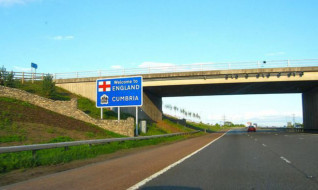Scottish drivers could be charged for taking their cars south of the border in the event of independence, the UK Government will claim this week.
In the next of a series of Scotland Analysis papers to be published on Tuesday Westminster will say HGV drivers would potentially be the most heavily affected by having to pay up to £10 a day.
However, the claims were dismissed by the SNP, who accused the UK Government of coming up with “feeble scare stories” and said Westminster policy imposes some of the highest fuel taxes in Europe on Scottish motorists.
The paper will say the implementation of the HGV Road User Levy Act 2013 will not hit the vast majority of vehicles registered in Scotland because of an offset reduction to Vehicle Excise Duty (VED).
However, operators from outside the UK will be required to pay a charge of up to £10 per day, or £1,000 per year.
The report will also say non-commercial vehicles registered in an independent Scotland would have to pay a registration fee, currently set at £55 and VED if they spent more than six months south of the border.
Scotland Office Minister David Mundell said: “Every time we look under the bonnet of independence we find something else problematic.
“Scottish motorists just want to be able to drive on UK roads with the minimum of fuss. They don’t want new charges, new driving licences or new MOTs.”
The analysis paper identifies the different bodies the UK Government says Scotland would need to create to replace the services provided by the UK government, like the administration of MOTs and Scotland’s 3.7 million driving licences.
However, SNP MP Angus MacNeil said: “Perhaps if they spent more time trying to address these problems and less time trying to dream up feeble scare stories, people in the road haulage industry would have more faith in Westminster.”
A Scottish Government spokeswoman said: “With independence, Scotland will gain full control of vehicle excise duty and fuel taxes.
“This will mean an independent Scottish Government can set these measures in line with the needs of Scotland’s hauliers and motorists.”
She added there would be “a range of options” for replacing UK driving institutions in the event of independence.
